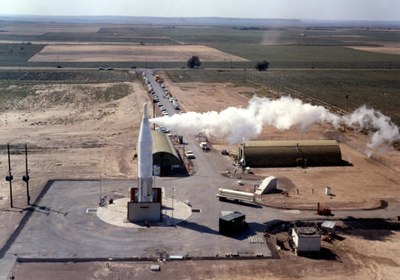About those scrapped Atlas ICBMsby Wayne Eleazer
|
| Atlas E/F rockets were cheap (less than one third the cost of a Titan II space booster conversion), reliable, had useful capabilities, and after the loss of the Challenger in 1986 it was no longer politically incorrect to use ELVs. |
We did not have “enough Atlas E’s to last until 1995.” We were not trying to get to 1995; we simply ran out of them because so many had been scrapped. The last converted Atlas E came off the VAMP production line in 1988. In the early 1980s we were even considering recovering an Atlas E/F airframe that had been sent to Lawrence Livermore Labs for use in calibrating a modal vibration test rig; it had been lying around unpressurized and I presume it was no longer suitable for conversion to a space booster. The USAF Museum lost the Atlas ICBM they had on display in the late 1980s when its pressurization system failed; we were not even able to provide them with a replacement. The X-24C was supposed to use an Atlas E engine but that effort was cancelled when we found we barely had enough engines to go around for the space launches. As it was, use of Atlas E for DMSP, Geosat, and Stacksat was possible only because an STP mission was cancelled due to cost overruns and one Atlas E/F payload moved over to the more powerful Atlas H.
We would have no doubt have launched all the Atlas E/F’s we had in any case; they were cheap (less than one third the cost of a Titan II space booster conversion), reliable, had useful capabilities, and after the loss of the Challenger in 1986 it was no longer politically incorrect to use ELVs. The cost of keeping the program going after the last vehicle completed conversion was a mere $20 million a year in 1993 dollars. No more payloads were assigned to Atlas E after 1988 because there would be no more of the boosters available, anyway. Payload integration is a process that literally takes years to accomplish and you don’t do it if there are none of that model booster available. In terms of assigning the vehicles to missions we “ran out” of Atlas E’s in 1987. ATN and DMSP were the last payloads flown on Atlas E but there could have been more missions if the boosters had been available. Assuming that they had been flown at the rate of two per year as they were for the last two payloads, we would still be launching them today.
By the way, anyone wanting some more information on the Atlas E and Atlas F should visit the remarkable website www.atlasmissilesilo.com. I will be providing some additional data and photos for that website and you can even download a copy of the Air Force Technical Orders for the Atlas E and Atlas F.
